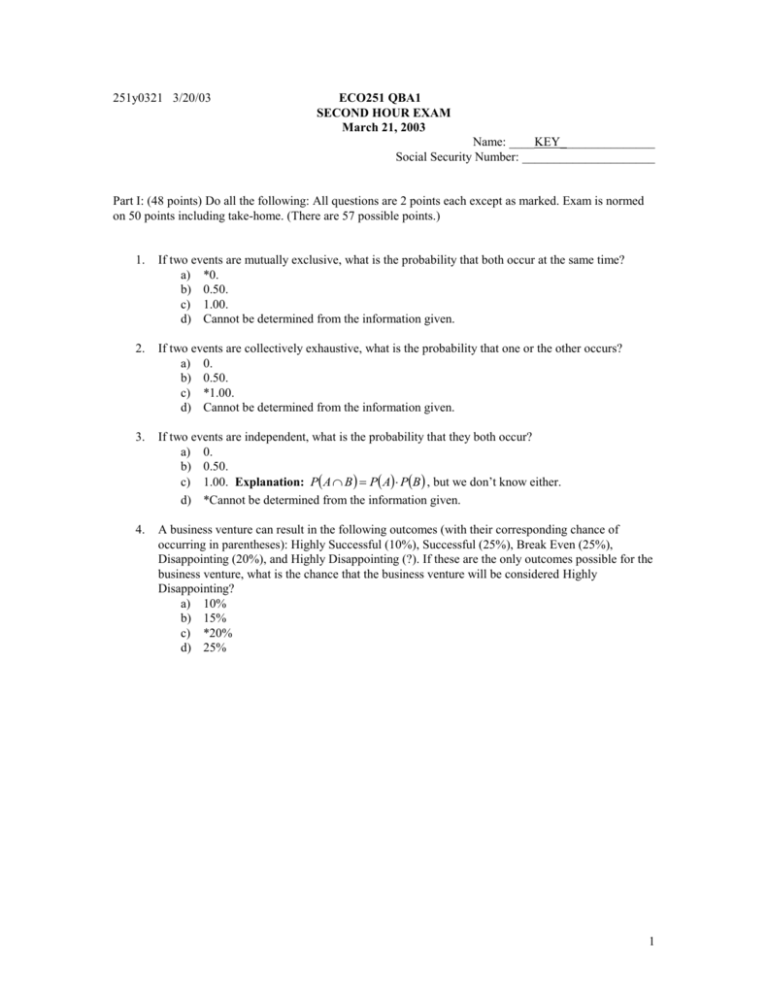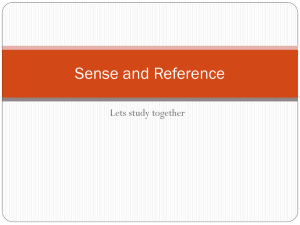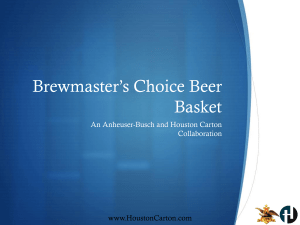251y0321
advertisement

251y0321 3/20/03 ECO251 QBA1 SECOND HOUR EXAM March 21, 2003 Name: ____KEY_______________ Social Security Number: _____________________ Part I: (48 points) Do all the following: All questions are 2 points each except as marked. Exam is normed on 50 points including take-home. (There are 57 possible points.) 1. If two events are mutually exclusive, what is the probability that both occur at the same time? a) *0. b) 0.50. c) 1.00. d) Cannot be determined from the information given. 2. If two events are collectively exhaustive, what is the probability that one or the other occurs? a) 0. b) 0.50. c) *1.00. d) Cannot be determined from the information given. 3. If two events are independent, what is the probability that they both occur? a) 0. b) 0.50. c) 1.00. Explanation: P A B P A PB , but we don’t know either. d) *Cannot be determined from the information given. 4. A business venture can result in the following outcomes (with their corresponding chance of occurring in parentheses): Highly Successful (10%), Successful (25%), Break Even (25%), Disappointing (20%), and Highly Disappointing (?). If these are the only outcomes possible for the business venture, what is the chance that the business venture will be considered Highly Disappointing? a) 10% b) 15% c) *20% d) 25% 1 251y0321 3/20/03 Show your work in problems 7-9. TABLE 5-4 The following table contains the probability distribution for X = the number of traffic accidents reported in a day in Corvallis, Oregon. X 0 1 2 3 4 5 P(X) 0.10 0.20 0.45 0.15 0.05 0.05 5. Referring to Table 5-4, the probability of at least 1 accident is ___.90_____. Explanation: Px 1 1 P1 6. Referring to Table 5-4, the mean or expected value of the number of accidents is __2.00__. 7. Referring to Table 5-4, the standard deviation of the number of accidents is _1.1832_. (4) Ex xPx 2.00 , E x2 x 2 Px 5.40 , 2 E x 2 2 5.40 2 2 1.40 , 1.40 1.1832 8. x 0 1 2 3 4 5 Sum P x .10 .20 .45 .15 .05 .05 1.00 xPx 0.00 0.20 0.90 0.45 0.20 0.25 2.00 x 2 P x 0.00 0.20 1.80 1.35 0.80 1.25 5.40 We sell a product with a markup of $7 per unit and have fixed costs of $500 monthly. Thus, if we sell 100 units, our profits will be $7(100) – 500 =$200. If our expected sales are 250 units and the standard deviation is 20, what is the mean and standard deviation of our profits? (4) Solution: Use the solution of problem J2. The formula says that if y ax b, y a x b and y2 a 2 x2 , so, if y 7 x 500, a 7 and b 500 . Then y 7 x 500 7250 500 1250 , and y2 a 2 x2 72 20 2 19600 . Thus y 19600 7 2 20 2 720 140 . . 2 251y0321 3/20/03 TABLE 4-2 An alcohol awareness task force at a Big-Ten university sampled 200 students after the midterm to ask them whether they went bar hopping the weekend before the midterm or spent the weekend studying, and whether they did well or poorly on the midterm. The following result was obtained. Did Well on Midterm Did Poorly on Midterm Studying for Exam 80 20 Went Bar Hopping 30 70 If we finish the table we get: Did Well Did Poorly Total on Midterm on Midterm Studying 80 20 100 for Exam Went Bar 30 70 100 Hopping Total 110 90 200 9. Referring to Table 4-2, what is the probability that a randomly selected student who went bar hopping will do well on the midterm? a. *30/100 Explanation: This is a conditional probability. Out of the 100 who went bar hopping, only 30 did well on the exam. b. 30/110 c. 30/200 d. (100/200)*(110/200) 10. Referring to Table 4-2, the events "Did Well on Midterm" and "Studying for Exam" are a) *statistically dependent. Explanation: To be independent the probability that someone did well on the midterm, which is 110 out of 200, has to be the same as the conditional probability that someone did well on the midterm, given that he/she studied for the exam, which is 80 out of 100. These fractions are not equal. b) mutually exclusive. c) collective exhaustive. d) None of the above. 11. Suppose A and B are events where P(A) = 0.4, P(B) = 0.5, and P(A B) = 0.1. Then P(B|A) = .25 . Explanation: Note that P A B PB A .1 and, by the multiplication rule, PB A PA B . PB A .1 .25 . Note that you can’t use Bayes’ Rule here because you don’t know P A .4 12. Suppose A and B are events where P(A) = 0.4, P(B) = 0.5, and P(A B) = 0.1. Then P(A B ) = .8 . Explanation: Note that by the addition rule, P A B P A PB P A B .4 .5 .1 .8 . 13. Evaluate C 452 270725 . Explanation: C rn n! n r ! r! . So C 452 52! 48 ! 4! 52 51 50 49 270725 4 3 2 1 3 251y0321 3/20/03 14. If I am playing a card game with hands of 4 cards. The deck contains 52 cards of which 13 are hearts. What is the chance that I get 2 hearts? Do not finish this problem – write out the answer 13! 39! 13!39! 11!2! 37!2! 13!39!48!4! using factorial notation. (4) 52!11!2!37!2! 11!37!2!2 270725 52! 48!4! Explanation: C rn n! n r ! r! . There are 13 hearts and 39 non-hearts in the deck. We need 2 of each. There are C 213 13! 39! to pick the hearts and C 239 ways to pick the non-hearts 11! 2! 37 ! 2! out of a total of C 452 48 ! 4! is P2 C 213C 239 C 452 52! 52 51 50 49 270725 ways to pick a hand of 4. The answer 4 3 2 1 13! 39! 11!2! 37!2! 13!39!48!4! 13 12 39 38 4 3 2 1 .2135 52!11!2!37!2! 2 1 2 1 52 51 50 49 52! 48!4! TABLE 4-4 Suppose that patrons of a restaurant were asked whether they preferred beer or whether they preferred wine. 70% said that they preferred beer. 60% of the patrons were male. 80% of the males preferred beer. 15. Referring to Table 4-4, the probability a randomly selected patron is a female is .40. 16. Referring to Table 4-4, the probability a randomly selected patron is a female who prefers beer is .22. 17. Referring to Table 4-4, suppose a randomly selected patron prefers wine. Then the probability the patron is a male is .40. (4) Explanation: Assume that 100 people walk into the restaurant. Let M be ‘male,’ F be ‘female,’ B be ‘beer’ and W be ‘wine.’ Given: PB .70, PM .60, P B M .80 . Since PM .60, PF 1 .60 .40. So 40 are women and 60 are men. 70 out of 100 prefer Beer, so 30 prefer wine. If we make this into a table, we get B W 60 M . We know that 80% of F 40 70 30 100 the 60 males or 48 of the men prefer beer. B W M 48 60 Our table now reads and 40 F 70 30 100 we can fill in the rest to give B W M 48 12 60 . F 22 18 40 70 30 100 So the probability that a randomly selected patron is a female who prefers beer is 22 out of 100 or PF B .22 , and the probability that a wine-drinker is male is 12 out of 30 or PM W 12 30 .40 . 4 251y0321 3/20/03 Using Bayes’ Rule, P M W P W M PM PW . But, since a male must prefer either beer or wine PW M 1 PB M 1 .80 .20. Similarly PW 1 PB 1 .70 .30. So P M W .20 .60 .40 . .30 TABLE 4-7 The next state lottery will have the following payoffs possible with their associated probabilities. Payoff Probability $2.00 0.0500 $25.00 0.0100 $100.00 0.0050 $500.00 0.0010 $5,000.00 0.0005 $10,000.00 0.0001 You buy a single ticket. 18. Referring to Table 4-7, the probability that you win any money is .0666. Explanation: 0.05 + .01 + .005 + .001 + .0005 + .0001 = .0666. 19. Referring to Table 4-7, the probability that you win at least $100.00 is .0066. Explanation: The probability that you win less than $100 is 0.05 + .01 = .06. So the probability that you both won and got at least $100 is .0666 - .06 = .0066. 20. Referring to Table 4-7, if you have a winning ticket, the probability that you win at least $100.00 is .099. (I will accept .1) Explanation: Let W be the event that you win and let H be the event that you win at least PH W .0066 $100. By the multiplication rule, P H W .099 . PW .0666 Another way to think about this is to say that 10000 people bought chances. Then .05(10000) = 500 got $2, 100 got $25, 50 got $100, 10 got $500, 5 got $5000 and one got $10000. This is a total of 666 winning tickets. Of these 66 got $100 or more. 666 out of 10000 is .0666. 66 out of 10000 is .0066. 66 out of 666 is .099. 5 251y0321 3/20/03 ECO251 QBA1 FIRST EXAM February 21, 2003 TAKE HOME SECTION Name: _________________________ Social Security Number: _________________________ Throughout this exam show your work! Please indicate clearly what sections of the problem you are answering and what formulas you are using. Part II. Do all the Following (9 Points) Show your work! 1. My Social Security Number is 265398248. Take the following set of numbers: 10 23 17 16 32 35 44 45 33 and use your Social Security Number to provide the first digit, so that , for me, the numbers would become 210, 623, 517, 316, 932, 835, 244, 445, 833. Compute a sample standard deviation for the resulting numbers. (3- 2point penalty for not doing) Solution: Of course, I faked this using Minitab. Here’s how I did it. I used the ‘edit’ menu to copy the row of numbers, opened Minitab, and used the ‘set’ instruction to copy in the numbers. My command sheet follows with comments. ————— 3/20/2003 8:13:29 PM ———————————————————— Welcome to Minitab, press F1 for help. MTB > set c1 DATA> 210, 623, 517, 316, 932, 835, 244, 445, 833. #These numbers copied from exam. DATA> end MTB > let c2=c1*c1 MTB > print c1 c2 #It printed out two columns. These are cut and pasted below. MTB > sum c1 Sum of C1 Sum of C1 = 4955.0 MTB > sum c2 Sum of C2 Sum of C2 = 3316673 MTB > describe c1 #Just to check my work. Descriptive Statistics: C1 Variable N C1 9 Variable C1 Minimum 210.0 Mean 550.6 Median 517.0 TrMean 550.6 Maximum 932.0 Q1 280.0 Q3 834.0 StDev 271.3 SE Mean 90.4 6 251y0321 3/20/03 Row 1 2 3 4 5 6 7 8 9 So x 4955 x 4955 , x 3316673 and n 9 . x n 9 550 .556 x nx 3316673 9550 .556 588670 .22 73583 .778 s 2 2 s2 x2 44100 388129 267289 99856 868624 697225 59536 198025 693889 3316673 x 210 623 517 316 932 835 244 445 833 4955 n 1 2 2 8 8 73583.778 271.26 Another way to speed up your work is to find out where your calculator keeps x and x 2 and to use the calculator to compute the standard deviation. You still have to write down the values of x and to compute x 2 , but the place where people spend the most time and make the most mistakes is in summing x 2 . You, of course, get the variance by squaring the standard deviation, and I’ll never know that you didn’t really do it. 7 251y0321 3/20/03 2. As everyone knows, a jorcillator has two components, a phillinx and a flubberall. It seems that the jorcillator only works as long as both components work. The probability of the phillinx failing in the first month of service is .1, and the probability of the phillinx failing in the second month is .3, while the probability of the flubberall failing in the first month is .7 and probability of the flubberall failing in the second month is .2. Failure of components is assumed to be independent, so the probability of both components failing in the first month is (.1) (.7) =.07 (This is not the probability that the jorcillator will fail in the first month!) a) What is the probability that the jorcillator will fail in the first month? b) What is the probability that the jorcillator will fail in the second month? c) What is the probability that the jorcillator will last beyond 2 months? Solution: This is a version of Problem H4. The probabilities you have are: Month Component 1 Component 2 1 .1 .7 2 .3 .2 3+ .6 .1 Let the table below define events A through E . Month Component 1 Component 2 Fails Fails 1 A D 2 B E C 3+ F There are two ways to do this. First, remember that if one component fails, the whole shebang fails. Thus P1 P A B P A PB P A B .1 .7 .1.7 .73 . The machine only lasts to period 3 if both components last to period 3. P3 PC F PC PF .6.1 .06 . Since the machine has to fail sometime, P2 1 P1 P3 1 .73 .06 .21 . Second, write down the joint events and their probabilities. Joint Event Probability Machine fails on day 1 A D .1.7 .07 .1.2 .02 .1.1 .01 .3.7 .21 .3.2 .06 .3.1 .03 .6.7 .42 .6.2 .12 A E A F BD BE BF CD CE CF 1 1 1 2 2 1 2 .6.1 .06 Sum 3 1.00 If we handle this with a joint probability table we can write it as: Events D E F A B C Total .07 .21 .42 .70 .02 .06 .12 .20 .01 .03 .06 .10 Total .10 .30 .60 1.00 If we add together probabilities for each day, Day 1 2 3+ Sum Probability of Failure .07 .02 .01 .21 .42 .73 .06 .03 .12 .21 .06 1.00 8








